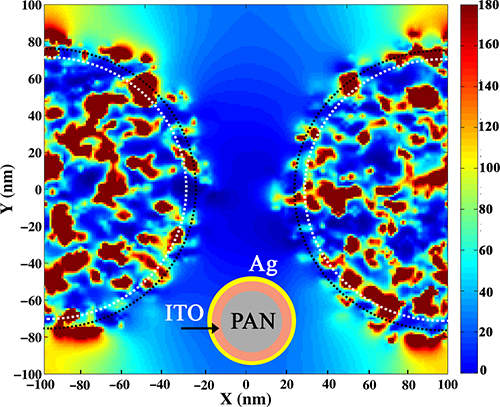Nanoimprinted Hybrid Metal-Semiconductor Plasmonic Multilayers with Controlled Surface Nano Architecture for Applications in NIR Detectors
Abstract
:1. Introduction
2. Results and Discussion
2.1. Electrode Fabrication
2.2. Discussion
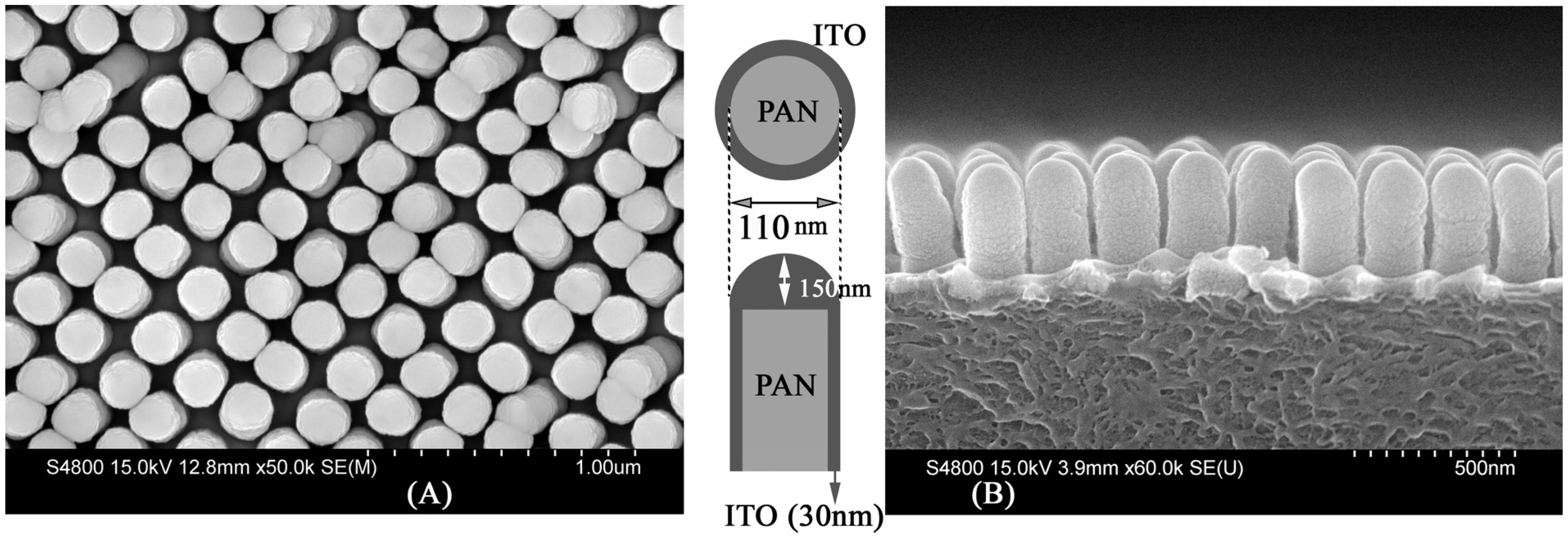
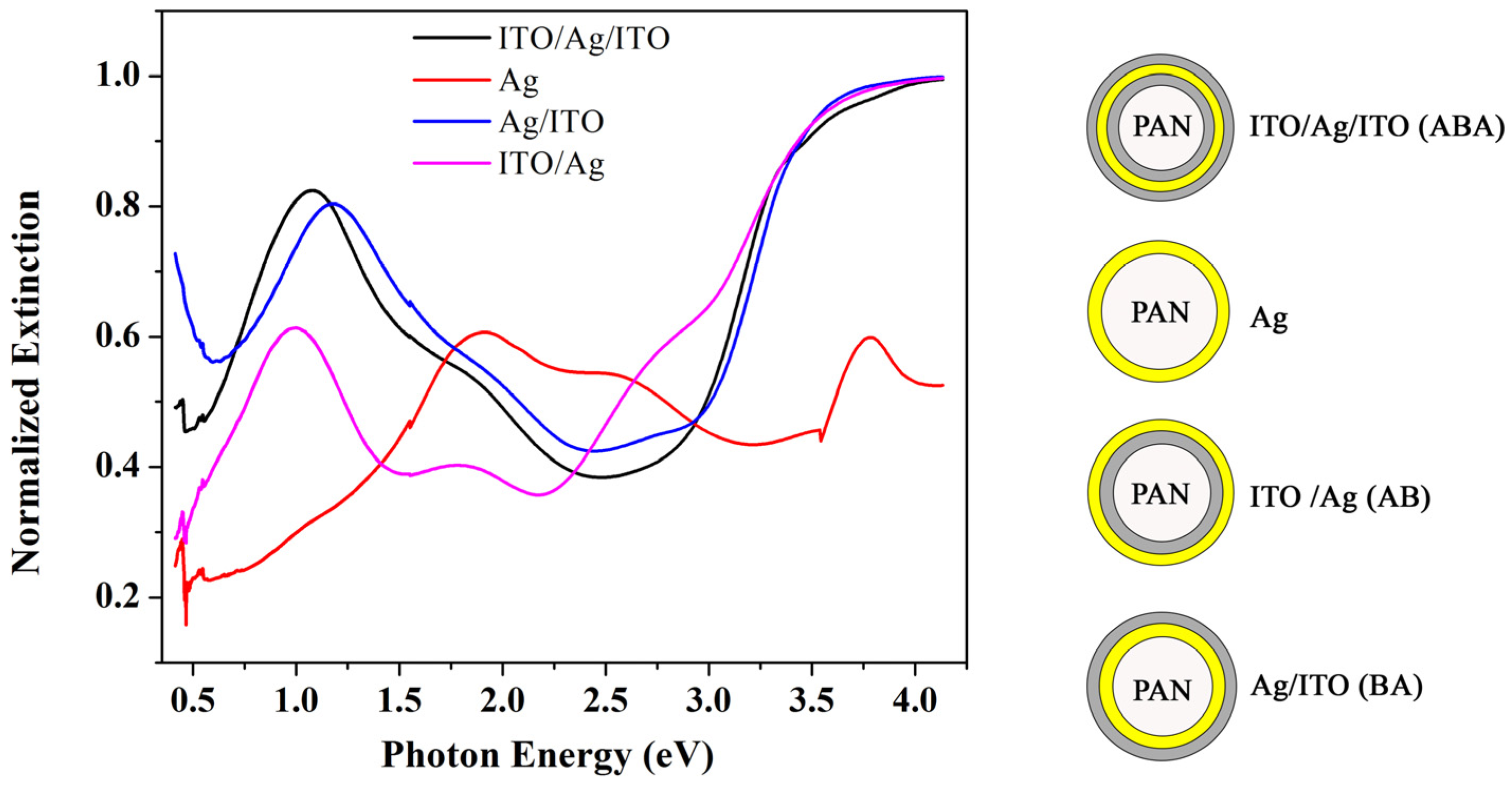
| Structure | Thickness (nm) | Resistivity (Ω/□) | Optical band gap (eV) | ||
|---|---|---|---|---|---|
| nanostructured | planar | nanostructured | bulk | ||
| ITO/Ag | 150/10 | 1800 | 10–15 | 2.75 | 3.22 |
| Ag/ITO | 10/150 | 65 | 15 | - | - |
| ITO/Ag/ITO | 70/10/70 | 150 | 7 | 2.79 | 3.14 |
| ITO | 180 | 2000 | 85 | 2.92 | 3.2 |
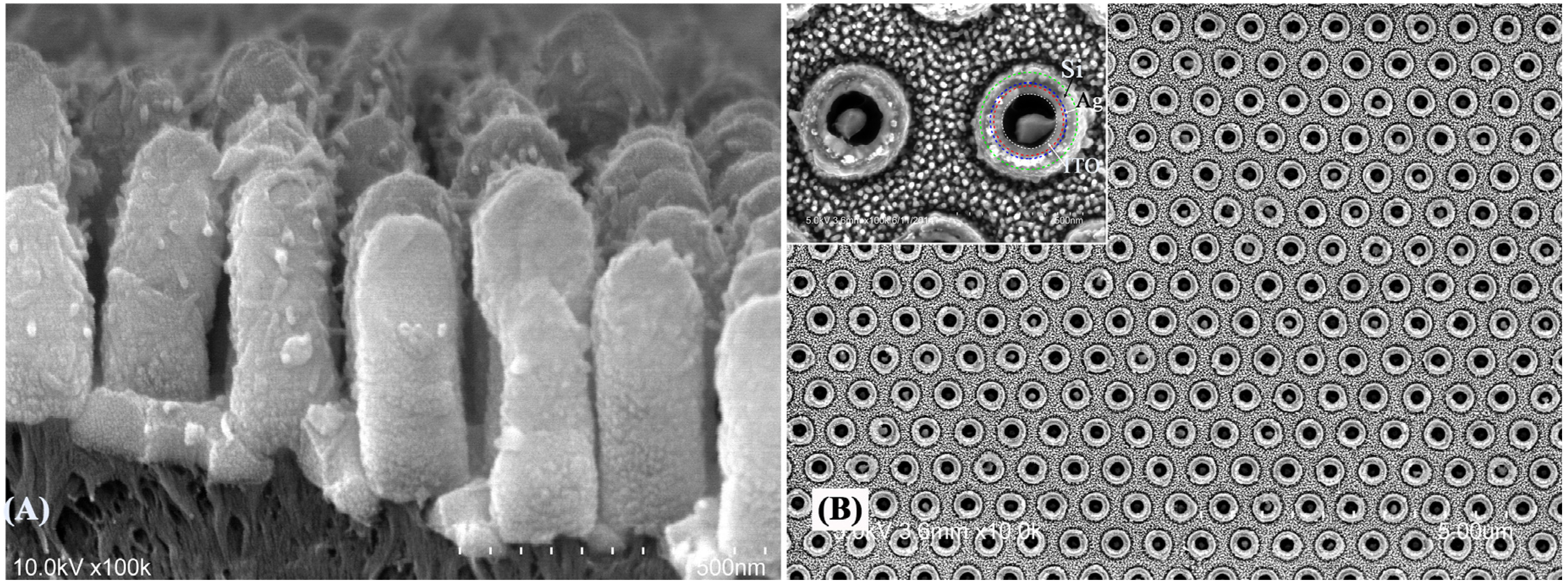
2.3. Surface Plasmon Polariton (SPP)
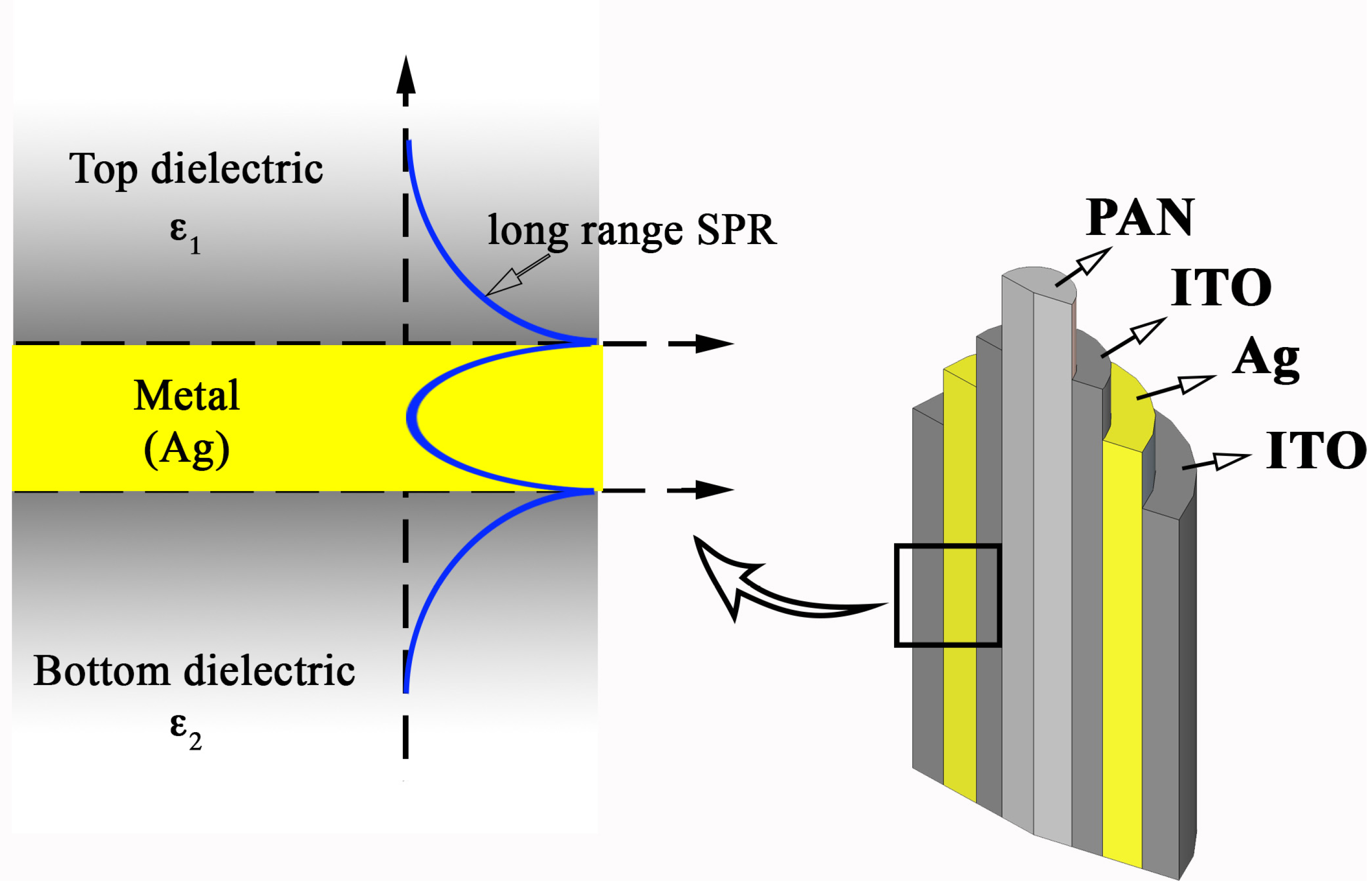
2.4. Plasmon Hybridization Model
2.5. Surface Plasmon Excitation in Ag Nanopillars
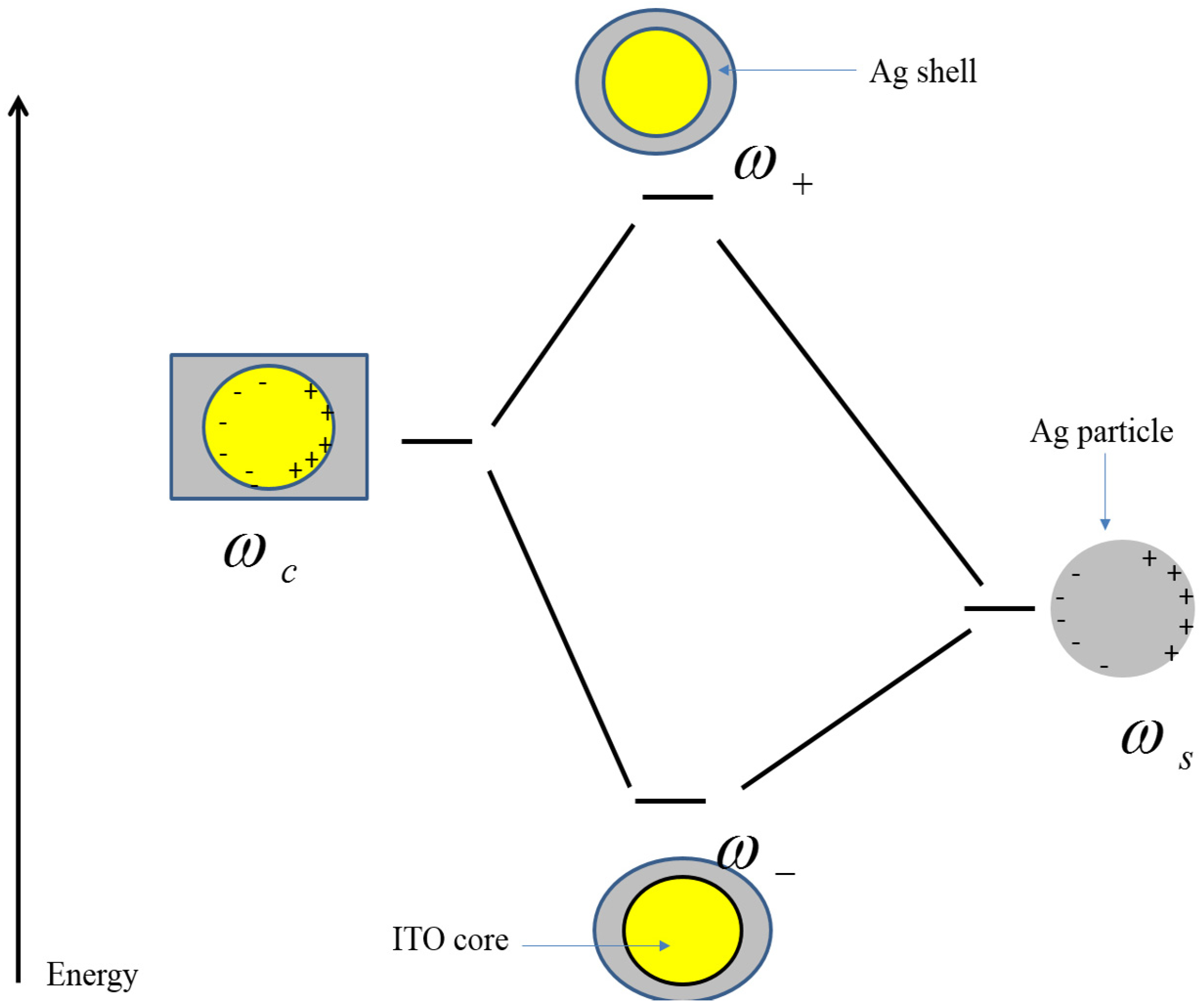
2.6. Hybrid Metal and Metal Oxide Core Shell Nanostructured Arrays
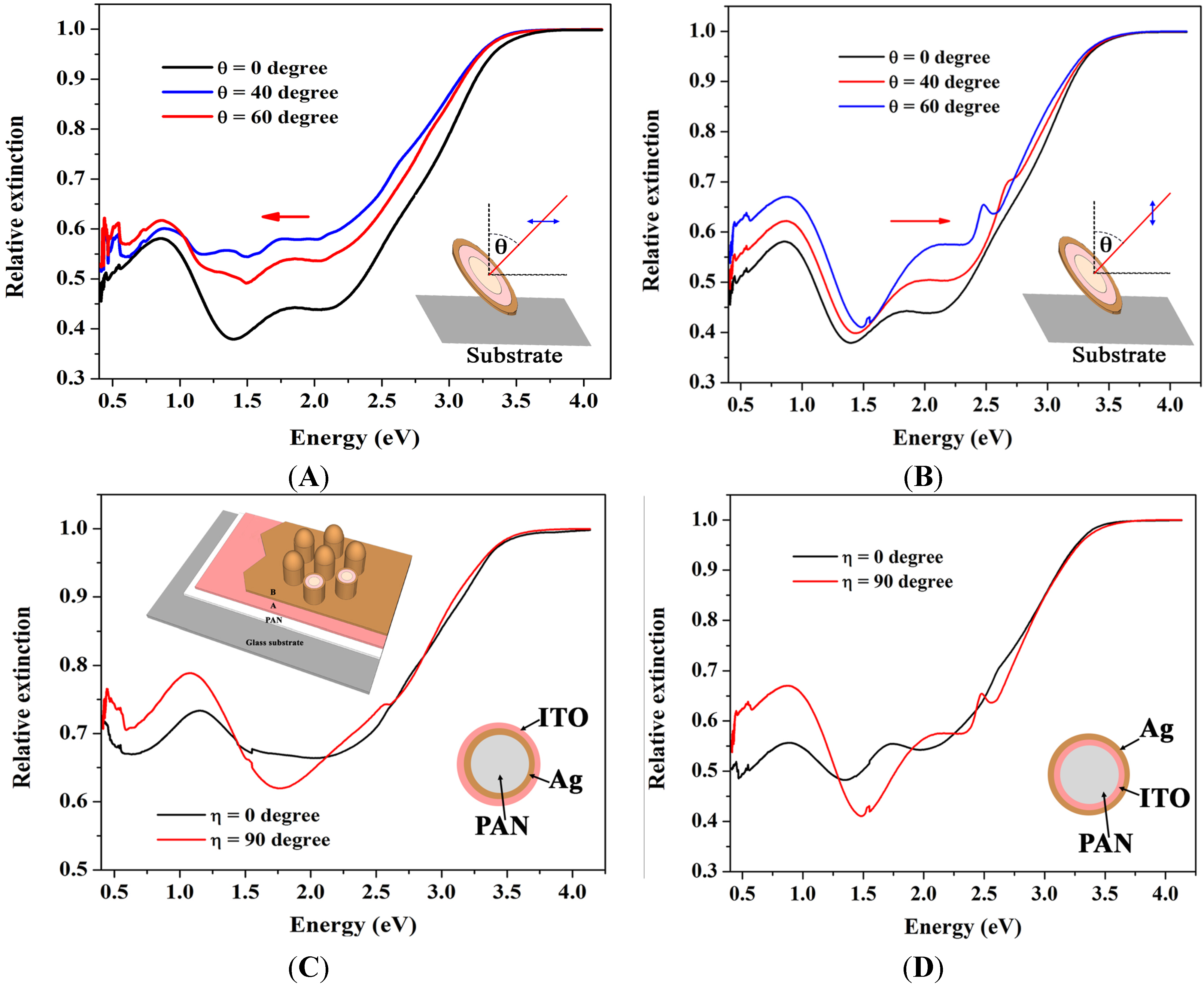
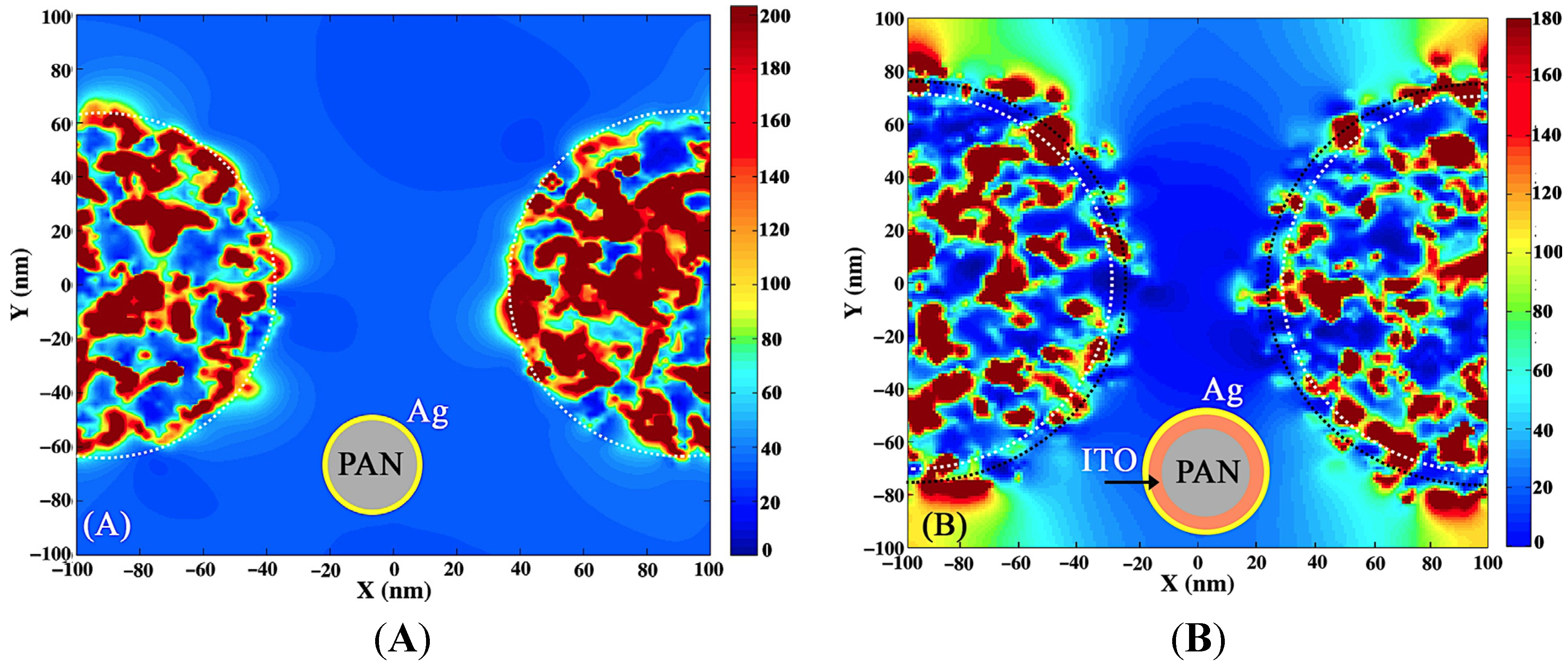
3. FDTD Simulation
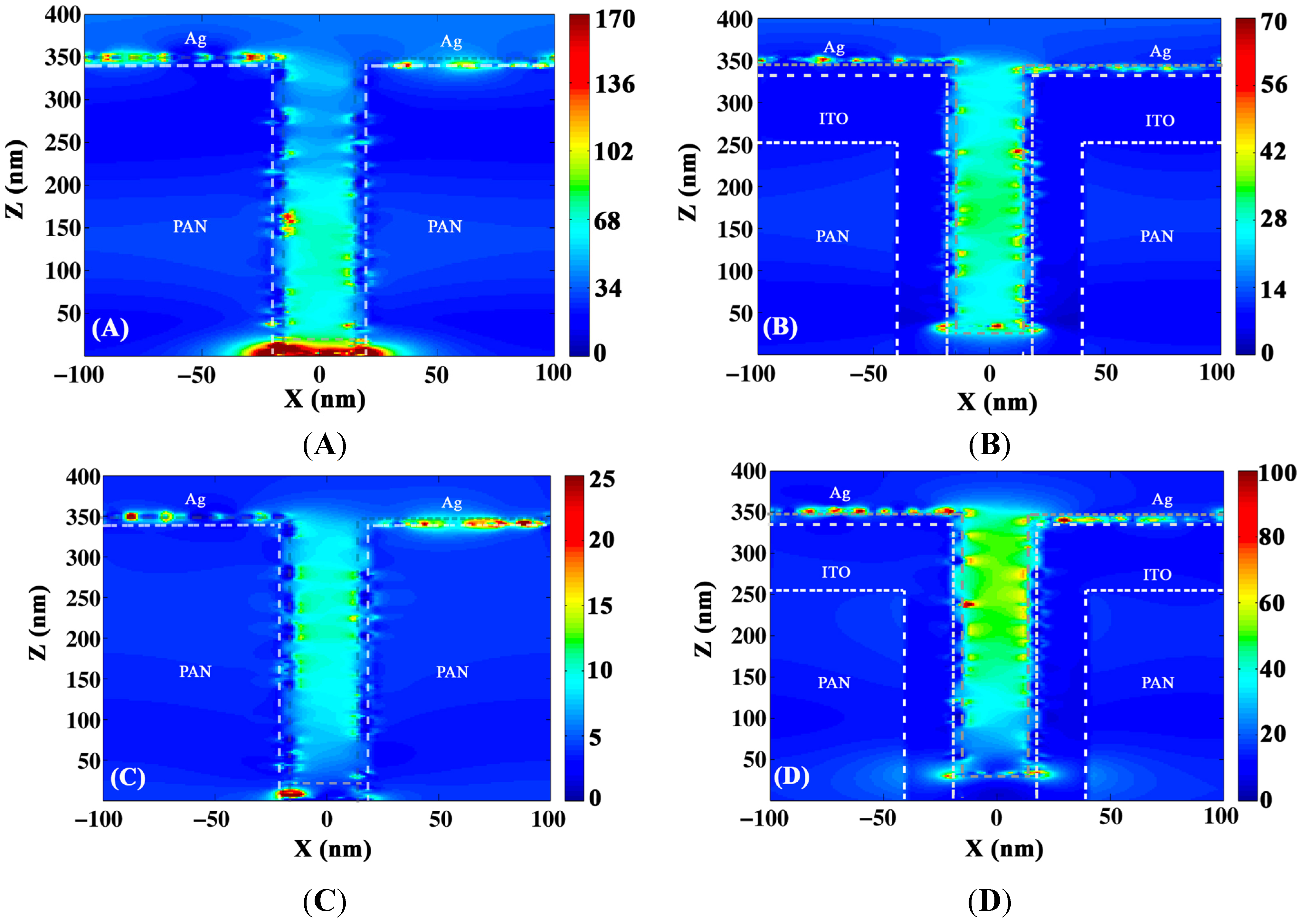
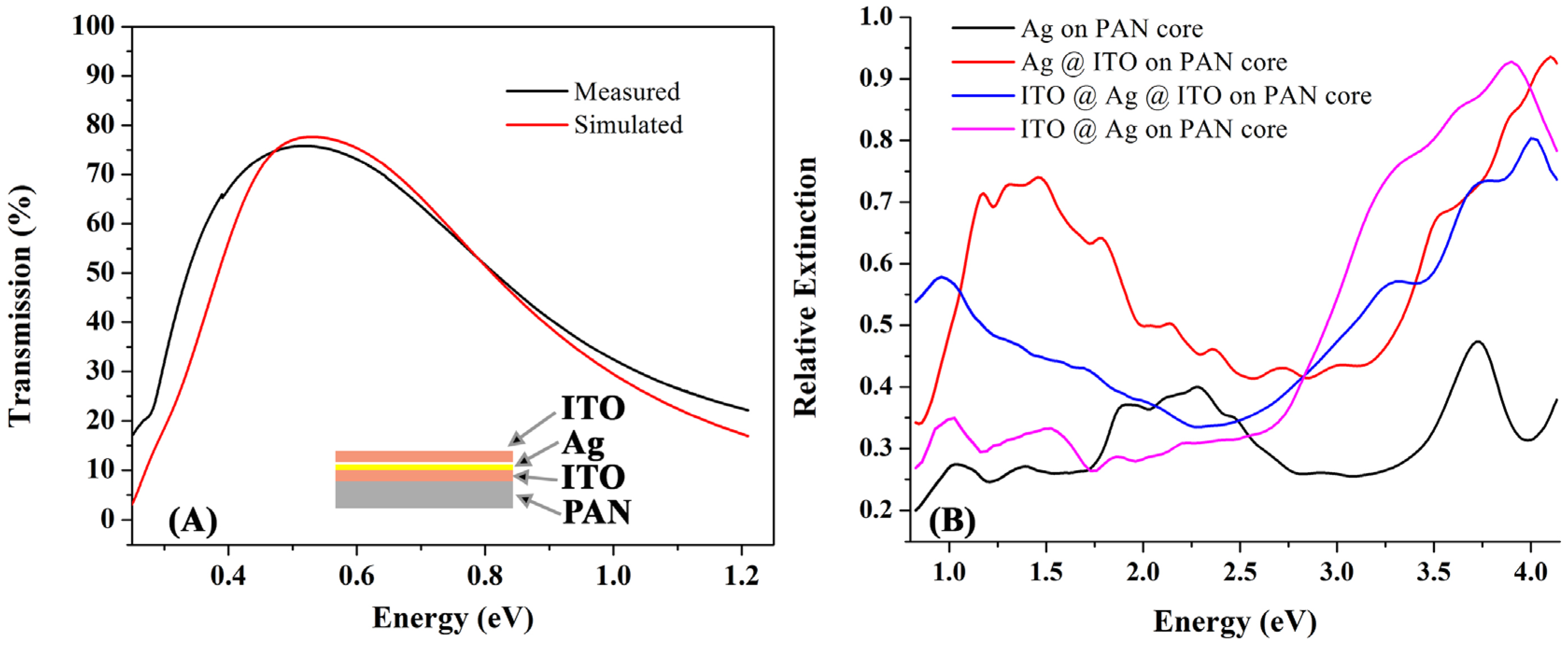
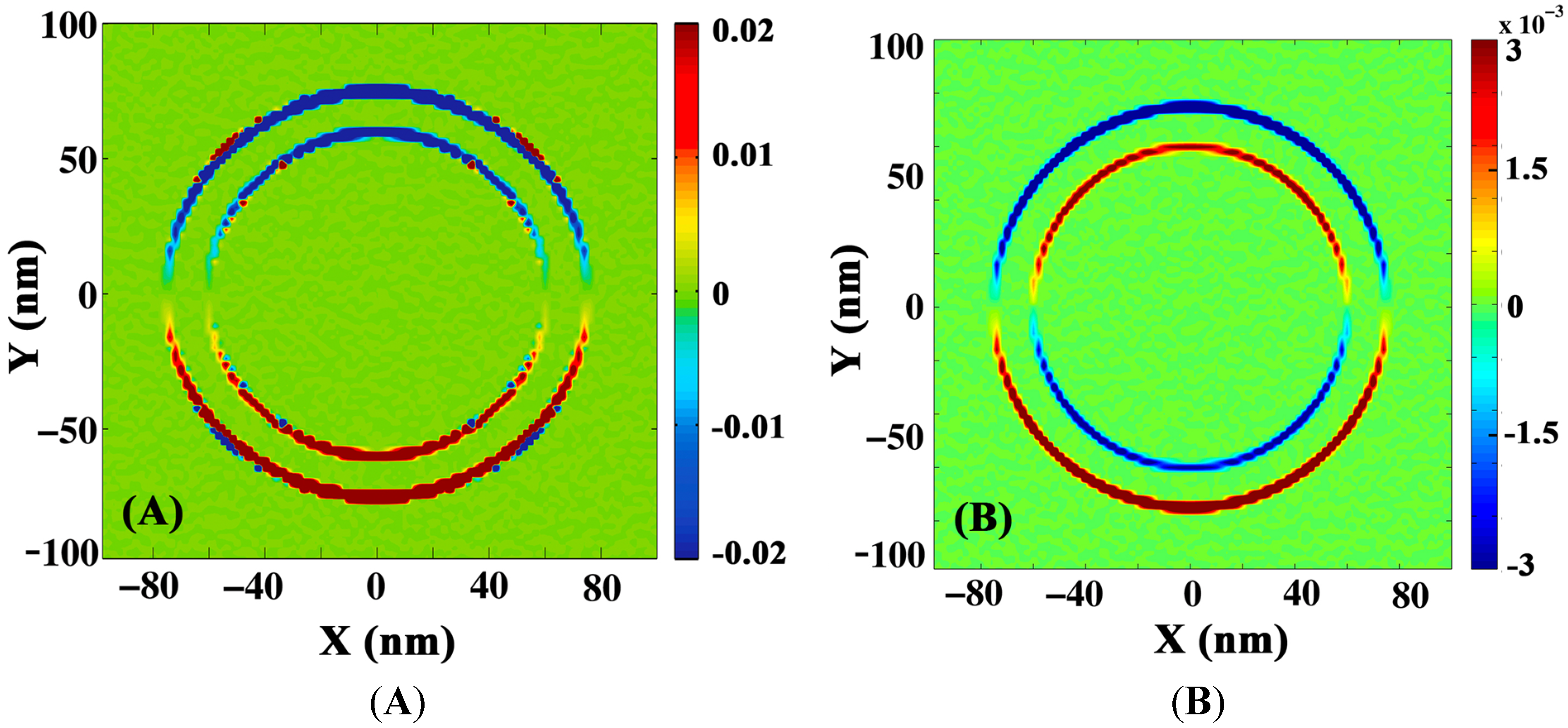
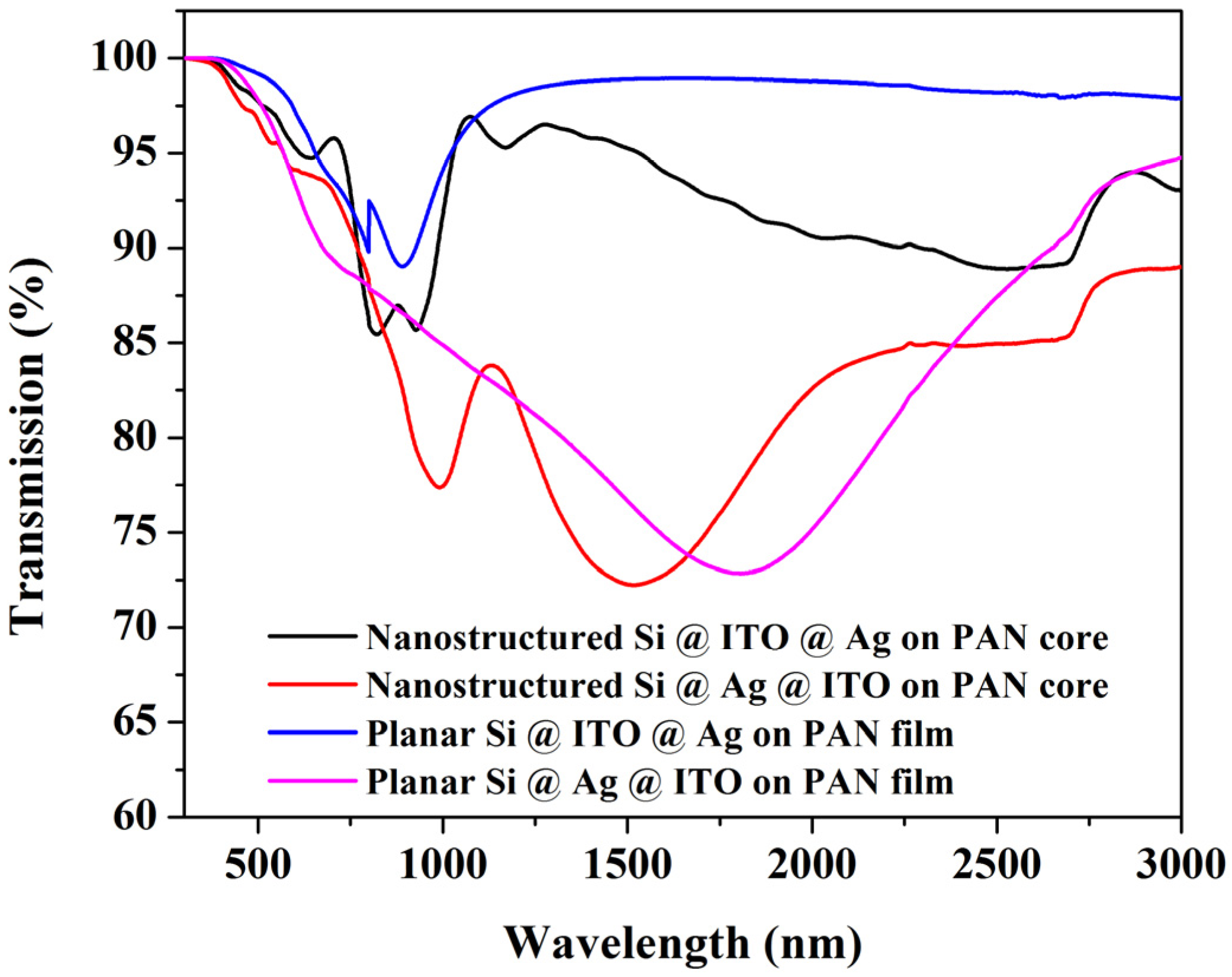
4. Conclusions
Acknowledgments
Author Contributions
Conflicts of Interest
References
- Jones, M.R.; Osberg, K.D.; Macfarlane, R.J.; Langille, M.R.; Mirkin, C.A. Templated techniques for the synthesis and assembly of plasmonic nanostructures. Chem. Rev. 2011, 111, 3736–3827. [Google Scholar] [CrossRef] [PubMed]
- Stockman, M.I. Nanoplasmonics: The physics behind the applications. Phys. Today 2011, 64, 39–44. [Google Scholar] [CrossRef]
- Willets, K.A.; Van Duyne, R.P. Localized surface plasmon resonance spectroscopy and sensing. Ann. Rev. Phys. Chem. 2007, 58, 267–297. [Google Scholar] [CrossRef] [PubMed]
- Bohren, C.F.; Huffman, D.R. Measured Optical Properties. In Absorption and Scattering of Light by Small Particles; Wiley-VCH Verlag GmbH: Weinheim, Germany, 2007. [Google Scholar]
- Hecht, B.; Bielefeldt, H.; Novotny, L.; Inouye, Y.; Pohl, D.W. Local excitation, scattering, and interference of surface plasmons. Phys. Rev. Lett. 1996, 77, 1889–1892. [Google Scholar] [CrossRef] [PubMed]
- Khosroabadi, A.A.; Matz, D.L.; Gangopadhyay, P.; Pemberton, J.E.; Norwood, R.A. Study of the c-60/ag interface of a large area nanoarchitectured ag substrate using surface-enhanced raman scattering. J. Phys. Chem. C 2014, 118, 18027–18034. [Google Scholar] [CrossRef]
- Barnes, W.L.; Dereux, A.; Ebbesen, T.W. Surface plasmon subwavelength optics. Nature 2003, 424, 824–830. [Google Scholar] [CrossRef] [PubMed]
- Atwater, H.A. The promise of plasmonics. Sci. Am. 2007, 296, 56–63. [Google Scholar] [CrossRef] [PubMed]
- Maier, S.A.; Atwater, H.A. Plasmonics: Localization and guiding of electromagnetic energy in metal/dielectric structures. J. Appl. Phys. 2005, 98. [Google Scholar] [CrossRef]
- Raza, S.; Wubs, M.; Bozhevolnyi, S.I.; Mortensen, N.A. Nonlocal study of ultimate plasmon hybridization. Opt. Lett. 2015, 40, 839–842. [Google Scholar] [CrossRef] [PubMed]
- Linic, S.; Christopher, P.; Ingram, D.B. Plasmonic-metal nanostructures for efficient conversion of solar to chemical energy. Nat. Mater. 2011, 10, 911–921. [Google Scholar] [CrossRef] [PubMed]
- Zhou, X.M.; Liu, G.; Yu, J.G.; Fan, W.H. Surface plasmon resonance-mediated photocatalysis by noble metal-based composites under visible light. J. Mater. Chem. 2012, 22, 21337–21354. [Google Scholar] [CrossRef]
- Wang, P.; Huang, B.B.; Dai, Y.; Whangbo, M.H. Plasmonic photocatalysts: Harvesting visible light with noble metal nanoparticles. Phys. Chem. Chem. Phys. 2012, 14, 9813–9825. [Google Scholar] [CrossRef] [PubMed]
- Xiao, M.D.; Jiang, R.B.; Wang, F.; Fang, C.H.; Wang, J.F.; Yu, J.C. Plasmon-enhanced chemical reactions. J. Mater. Chem. A 2013, 1, 5790–5805. [Google Scholar] [CrossRef]
- Hou, W.B.; Cronin, S.B. A review of surface plasmon resonance-enhanced photocatalysis. Adv. Funct. Mater. 2013, 23, 1612–1619. [Google Scholar] [CrossRef]
- Jiang, R.; Li, B.; Fang, C.; Wang, J. Metal/semiconductor hybrid nanostructures for plasmon-enhanced applications. Adv. Mater. 2014, 26, 5274–5309. [Google Scholar] [CrossRef] [PubMed]
- King, P.W. Designing interfaces of hydrogenase-nanomaterial hybrids for efficient solar conversion. Biochim. Biophys. Acta Bioenerg. 2013, 1827, 949–957. [Google Scholar] [CrossRef] [PubMed]
- Song, H. Metal hybrid nanoparticles for catalytic organic and photochemical transformations. Acc. Chem. Res. 2015, 48, 491–499. [Google Scholar] [CrossRef] [PubMed]
- Chng, L.L.; Erathodiyil, N.; Ying, J.Y. Nanostructured catalysts for organic transformations. Acc. Chem. Res. 2013, 46, 1825–1837. [Google Scholar] [CrossRef] [PubMed]
- Rigo, M.V.; Seo, J. Probing plasmon polarization-mediated photoluminescence enhancement on metal-semiconductor hybrid optical nanostructures. Chem. Phys. Lett. 2011, 517, 190–195. [Google Scholar] [CrossRef]
- Haridas, M.; Tripathi, L.N.; Basu, J.K. Photoluminescence enhancement and quenching in metal-semiconductor quantum dot hybrid arrays. Appl. Phys. Lett. 2011, 98. [Google Scholar] [CrossRef]
- Hammarstrom, L. Accumulative charge separation for solar fuels production: Coupling light-induced single electron transfer to multielectron catalysis. Acc. Chem. Res. 2015, 48, 840–850. [Google Scholar] [CrossRef] [PubMed]
- Schladt, T.D.; Shukoor, M.I.; Schneider, K.; Tahir, M.N.; Natalio, F.; Ament, I.; Becker, J.; Jochum, F.D.; Weber, S.; Koehler, O.; et al. Au@MnO nanoflowers: Hybrid nanocomposites for selective dual functionalization and imaging. Angew. Chem. Int. Ed. 2010, 49, 3976–3980. [Google Scholar] [CrossRef] [PubMed]
- Dong, W.; Li, Y.; Niu, D.; Ma, Z.; Gu, J.; Chen, Y.; Zhao, W.; Liu, X.; Liu, C.; Shi, J. Facile synthesis of monodisperse superparamagnetic Fe3O4 core@hybrid@au shell nanocomposite for bimodal imaging and photothermal therapy. Adv. Mater. 2011, 23, 5392–5397. [Google Scholar] [CrossRef] [PubMed]
- Wang, X.; Liu, H.; Chen, D.; Meng, X.; Liu, T.; Fu, C.; Hao, N.; Zhang, Y.; Wu, X.; Ren, J.; et al. Multifunctional Fe3O4@p(st/maa)@chitosan@au core/shell nanoparticles for dual imaging and photothermal therapy. Acs Appl. Mater. Interfaces 2013, 5, 4966–4971. [Google Scholar] [CrossRef] [PubMed]
- Roelkens, G.; Van Thourhout, D.; Baets, R.; Notzel, R.; Smit, M. Laser emission and photodetection in an inp/ingaasp layer integrated on and coupled to a silicon-on-insulator waveguide circuit. Opt. Express 2006, 14, 8154–8159. [Google Scholar] [CrossRef] [PubMed]
- Chen, L.; Lipson, M. Ultra-low capacitance and high speed germanium photodetectors on silicon. Opt. Express 2009, 17, 7901–7906. [Google Scholar] [CrossRef] [PubMed]
- Desiatov, B.; Goykhman, I.; Shappir, J.; Levy, U. Defect-assisted sub-bandgap avalanche photodetection in interleaved carrier-depletion silicon waveguide for telecom band. Appl. Phys. Lett. 2014, 104. [Google Scholar] [CrossRef]
- Hayakawa, R.; Ishikura, N.; Nguyen, H.C.; Baba, T. Two-photon-absorption photodiodes in Si photonic-crystal slow-light waveguides. Appl. Phys. Lett. 2013, 102. [Google Scholar] [CrossRef]
- Kagawa, T.; Ooami, S. Polarization dependence of two-photon absorption in Si avalanche photodiodes. Jpn. J. Appl. Phys. Part 1 Reg. Papers Br. Commun. Rev. Papers 2007, 46, 664–668. [Google Scholar] [CrossRef]
- Knight, M.W.; Sobhani, H.; Nordlander, P.; Halas, N.J. Photodetection with active optical antennas. Science 2011, 332, 702–704. [Google Scholar] [CrossRef] [PubMed]
- Giugni, A.; Torre, B.; Toma, A.; Francardi, M.; Malerba, M.; Alabastri, A.; Zaccaria, R.P.; Stockman, M.I.; Di Fabrizio, E. Hot-electron nanoscopy using adiabatic compression of surface plasmons. Nat. Nanotechnol. 2013, 8, 845–852. [Google Scholar] [CrossRef] [PubMed]
- Sobhani, A.; Knight, M.W.; Wang, Y.; Zheng, B.; King, N.S.; Brown, L.V.; Fang, Z.; Nordlander, P.; Halas, N.J. Narrowband photodetection in the near-infrared with a plasmon-induced hot electron device. Nat. Commun. 2013, 4. [Google Scholar] [CrossRef] [PubMed]
- Li, W.; Valentine, J. Metamaterial perfect absorber based hot electron photodetection. Nano Lett. 2014, 14, 3510–3514. [Google Scholar] [CrossRef] [PubMed]
- Lin, K.-T.; Chen, H.-L.; Lai, Y.-S.; Yu, C.-C. Silicon-based broadband antenna for high responsivity and polarization-insensitive photodetection at telecommunication wavelengths. Nat. Commun. 2014, 5. [Google Scholar] [CrossRef] [PubMed]
- Binh, D.; Khurshid, H.; Gangopadhyay, P.; Devkota, J.; Stojak, K.; Srikanth, H.; Tetard, L.; Norwood, R.A.; Peyghambarian, N.; Manh-Huong, P.; et al. Enhanced magnetism in highly ordered magnetite nanoparticle-filled nanohole arrays. Small 2014, 10, 2840–2848. [Google Scholar]
- Khosroabadi, A.A.; Gangopadhyay, P.; Cocilovo, B.; Makai, L.; Basa, P.; Duong, B.; Thomas, J.; Norwood, R.A. Spectroscopic ellipsometry on metal and metal-oxide multilayer hybrid plasmonic nanostructures. Opt. Lett. 2013, 38, 3969–3972. [Google Scholar] [CrossRef] [PubMed]
- Khosroabadi, A.A.; Gangopadhyay, P.; Duong, B.; Thomas, J.; Sigdel, A.K.; Berry, J.J.; Gennett, T.; Peyghambarian, N.; Norwood, R.A. Fabrication, electrical and optical properties of silver, indium tin oxide (ITO), and indium zinc oxide (IZO) nanostructure arrays. Phys. Status Solidi 2013, 210, 831–838. [Google Scholar] [CrossRef]
- Schneider, C.A.; Rasband, W.S.; Eliceiri, K.W. Nih image to imagej: 25 years of image analysis. Nat. Methods 2012, 9, 671–675. [Google Scholar] [CrossRef] [PubMed]
- Luther, J.M.; Jain, P.K.; Ewers, T.; Alivisatos, A.P. Localized surface plasmon resonances arising from free carriers in doped quantum dots. Nat. Mater. 2011, 10, 361–366. [Google Scholar] [CrossRef] [PubMed]
- LaForge, J.M.; Cocker, T.L.; Beaudry, A.L.; Cui, K.; Tucker, R.T.; Taschuk, M.T.; Hegmann, F.A.; Brett, M.J. Conductivity control of as-grown branched indium tin oxide nanowire networks. Nanotechnology 2014, 25. [Google Scholar] [CrossRef] [PubMed]
- Bisquert, J.; Mora-Seró, I. Simulation of steady-state characteristics of dye-sensitized solar cells and the interpretation of the diffusion length. J. Phys. Chem. Lett. 2009, 1, 450–456. [Google Scholar] [CrossRef]
- Khosroabadi, A.A.; Gangopadhyay, P.; Cocilovo, B.; Norwood, R.A. Light Harvesting in Organic Solar Cells Using a Nanostructured ITO Grating. In Proceedings of the Photovoltaic Specialists Conference (PVSC), Tampa, FL, USA, 16–21 June 2013.
- Prodan, E.; Radloff, C.; Halas, N.; Nordlander, P. A hybridization model for the plasmon response of complex nanostructures. Science 2003, 302, 419–422. [Google Scholar] [CrossRef] [PubMed]
- Morfa, A.J.; Rowlen, K.L.; Reilly, T.H., III; Romero, M.J.; van de Lagemaat, J. Plasmon-enhanced solar energy conversion in organic bulk heterojunction photovoltaics. Appl. Phys. Lett. 2008, 92. [Google Scholar] [CrossRef]
- Kim, E.; Jiang, Z.-T.; No, K. Measurement and calculation of optical band gap of chromium aluminum oxide films. Jpn. J. Appl. Phys. 2000, 39. [Google Scholar] [CrossRef]
- Roman, L.; Valaski, R.; Canestraro, C.D.; Magalhaes, E.; Persson, C.; Ahuja, R. Optical band-edge absorption of oxide compound SnO2. Appl. Surf. Sci. 2006, 252, 5361–5364. [Google Scholar] [CrossRef]
- Granqvist, C.; Hultåker, A. Transparent and conducting ito films: New developments and applications. Thin Solid Films 2002, 411, 1–5. [Google Scholar] [CrossRef]
- Akiyama, H.; Pfeiffer, L.N.; Pinczuk, A.; West, K.W.; Yoshita, M. Observation of large many-body coulomb interaction effects in a doped quantum wire. Solid State Commun. 2002, 122, 169–173. [Google Scholar] [CrossRef]
- Zhu, W.; Qiu, X.; Iancu, V.; Chen, X.-Q.; Pan, H.; Wang, W.; Dimitrijevic, N.M.; Rajh, T.; Meyer, H.M., III; Paranthaman, M.P. Band gap narrowing of titanium oxide semiconductors by noncompensated anion-cation codoping for enhanced visible-light photoactivity. Phys. Rev. Lett. 2009, 103. [Google Scholar] [CrossRef]
- Pitarke, J.; Silkin, V.; Chulkov, E.; Echenique, P. Theory of surface plasmons and surface-plasmon polaritons. Rep. Progr. Phys. 2007, 70. [Google Scholar] [CrossRef]
- Wark, A.W.; Lee, H.J.; Corn, R.M. Long-range surface plasmon resonance imaging for bioaffinity sensors. Analyt. Chem. 2005, 77, 3904–3907. [Google Scholar] [CrossRef] [PubMed]
- Szunerits, S.; Castel, X.; Boukherroub, R. Surface plasmon resonance investigation of silver and gold films coated with thin indium tin oxide layers: Influence on stability and sensitivity. J. Phys. Chem. C 2008, 112, 15813–15817. [Google Scholar] [CrossRef]
- Franzen, S. Surface plasmon polaritons and screened plasma absorption in indium tin oxide compared to silver and gold. J. Phys. Chem. C 2008, 112, 6027–6032. [Google Scholar] [CrossRef]
- Dresselhaus, M. Solid state physics part ii-optical properties of solids. Lect. Notes Part 1999, 2, 12–15. [Google Scholar]
- Franzen, S.; Rhodes, C.; Cerruti, M.; Gerber, R.W.; Losego, M.; Maria, J.-P.; Aspnes, D. Plasmonic phenomena in indium tin oxide and ito-au hybrid films. Opt. Lett. 2009, 34, 2867–2869. [Google Scholar] [CrossRef] [PubMed]
- Zhang, Y.; Fei, G.T.; De Zhang, L. Plasmon hybridzation in coated metallic nanosphere. J. Appl. Phys. 2011, 109. [Google Scholar] [CrossRef]
- Prodan, E.; Nordlander, P. Plasmon hybridization in spherical nanoparticles. J. Chem. Phys. 2004, 120, 5444–5454. [Google Scholar] [CrossRef] [PubMed]
- Moradi, A. Plasmon hybridization in metallic nanotubes. J. Phys. Chem. Solids 2008, 69, 2936–2938. [Google Scholar] [CrossRef]
- Lal, S.; Link, S.; Halas, N.J. Nano-optics from sensing to waveguiding. Nat. Photon. 2007, 1, 641–648. [Google Scholar] [CrossRef]
- Lee, K.-C.; Lin, S.-J.; Lin, C.-H.; Tsai, C.-S.; Lu, Y.-J. Size effect of ag nanoparticles on surface plasmon resonance. Surface Coat. Technol. 2008, 202, 5339–5342. [Google Scholar] [CrossRef]
- Brandl, D.W.; Nordlander, P. Plasmon modes of curvilinear metallic core/shell particles. J. Chem. Phys. 2007, 126. [Google Scholar] [CrossRef] [PubMed]
- Prodan, E.; Lee, A.; Nordlander, P. The effect of a dielectric core and embedding medium on the polarizability of metallic nanoshells. Chem. Phys. Lett. 2002, 360, 325–332. [Google Scholar] [CrossRef]
- Kullock, R.; Hendren, W.R.; Hille, A.; Grafström, S.; Evans, P.R.; Pollard, R.J.; Atkinson, R.; Eng, L.M. Polarization conversion through collective surface plasmons in metallicnanorod arrays. Opt. Express 2008, 16, 21671–21681. [Google Scholar] [CrossRef] [PubMed]
- Atkinson, R.; Hendren, W.R.; Wurtz, G.A.; Dickson, W.; Zayats, A.V.; Evans, P.; Pollard, R.J. Anisotropic optical properties of arrays of gold nanorods embedded in alumina. Phys. Rev. B 2006, 73. [Google Scholar] [CrossRef]
- Zong, R.-L.; Zhou, J.; Li, Q.; Du, B.; Li, B.; Fu, M.; Qi, X.-W.; Li, L.-T.; Buddhudu, S. Synthesis and optical properties of silver nanowire arrays embedded in anodic alumina membrane. J. Phys. Chem. B 2004, 108, 16713–16716. [Google Scholar] [CrossRef]
- Evans, P.R.; Kullock, R.; Hendren, W.R.; Atkinson, R.; Pollard, R.J.; Eng, L.M. Optical transmission properties and electric field distribution of interacting 2D silver nanorod arrays. Adv. Funct. Mater. 2008, 18, 1075–1079. [Google Scholar] [CrossRef] [Green Version]
- Prodan, E.; Nordlander, P.; Halas, N. Effects of dielectric screening on the optical properties of metallic nanoshells. Chem. Phys. Lett. 2003, 368, 94–101. [Google Scholar] [CrossRef]
- Aden, A.L.; Kerker, M. Scattering of electromagnetic waves from two concentric spheres. J. Appl. Phys. 1951, 22, 1242–1246. [Google Scholar] [CrossRef]
© 2015 by the authors; licensee MDPI, Basel, Switzerland. This article is an open access article distributed under the terms and conditions of the Creative Commons Attribution license (http://creativecommons.org/licenses/by/4.0/).
Share and Cite
Khosroabadi, A.A.; Gangopadhyay, P.; Hernandez, S.; Kim, K.; Peyghambarian, N.; Norwood, R.A. Nanoimprinted Hybrid Metal-Semiconductor Plasmonic Multilayers with Controlled Surface Nano Architecture for Applications in NIR Detectors. Materials 2015, 8, 5028-5047. https://doi.org/10.3390/ma8085028
Khosroabadi AA, Gangopadhyay P, Hernandez S, Kim K, Peyghambarian N, Norwood RA. Nanoimprinted Hybrid Metal-Semiconductor Plasmonic Multilayers with Controlled Surface Nano Architecture for Applications in NIR Detectors. Materials. 2015; 8(8):5028-5047. https://doi.org/10.3390/ma8085028
Chicago/Turabian StyleKhosroabadi, Akram A., Palash Gangopadhyay, Steven Hernandez, Kyungjo Kim, Nasser Peyghambarian, and Robert A. Norwood. 2015. "Nanoimprinted Hybrid Metal-Semiconductor Plasmonic Multilayers with Controlled Surface Nano Architecture for Applications in NIR Detectors" Materials 8, no. 8: 5028-5047. https://doi.org/10.3390/ma8085028
APA StyleKhosroabadi, A. A., Gangopadhyay, P., Hernandez, S., Kim, K., Peyghambarian, N., & Norwood, R. A. (2015). Nanoimprinted Hybrid Metal-Semiconductor Plasmonic Multilayers with Controlled Surface Nano Architecture for Applications in NIR Detectors. Materials, 8(8), 5028-5047. https://doi.org/10.3390/ma8085028





